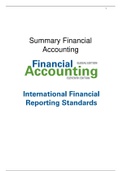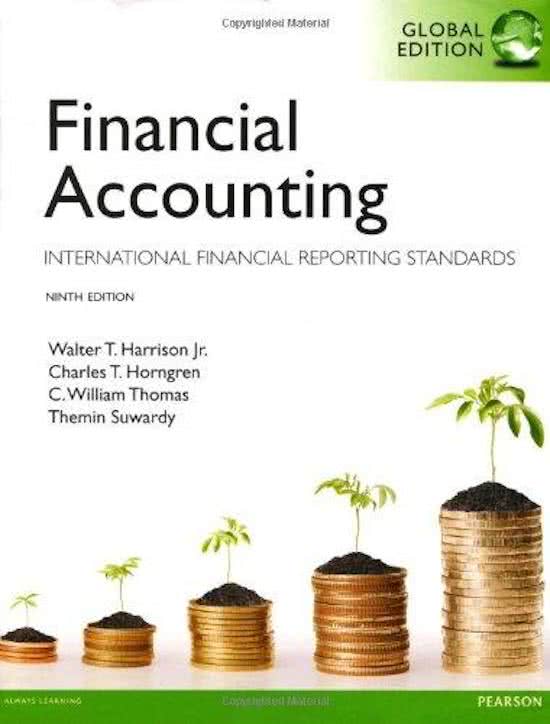1
Summary Financial
Accounting
, 2
Conceptual Framework and Financial
Statements
1. Understand the role of accounting in communicating financial
information
Accounting is an information system that:
➢ Measures business activities
➢ Processes data into reports
➢ Communicates results to decision makers
Accounting helps companies, their shareholders,
and management make the following decisions:
➢ Sources of funding and capital
➢ Costing and pricing
➢ Analyse the performance of various business
groups within the company
Accounting is the language of communication in all
businesses. The better our understanding of this language, the better we can understand our
finances, our businesses, or our investments.
It is used by:
➢ Individuals
➢ Investors and creditors
➢ Regulatory bodies (Government, tax department, etc.)
Double entry system of bookkeeping → The basis of financial reporting to shareholders.
Financial Accounting Management Accounting
For decision makers outside of the entity: For managers inside the entity:
✓ Investors ✓ Budgets
✓ Creditors ✓ Forecasts
✓ Government agencies ✓ Projections
✓ The public
Different forms of businesses:
➢ Proprietorship
➢ Partnership
➢ Corporation
Proprietorship
➢ Single owner
➢ Small retail stores or solo providers of professional services
➢ Personally liable for all business’s debts
➢ Distinct entity → Separate from its proprietor, for accounting purposes
, 3
Partnership
➢ Two or more parties as co-owners
➢ Income and losses “flow through” to partners (they recognize it based on their
agreed-upon percentage interest in the business)
➢ Mostly small or medium-sized companies
➢ General partnerships have mutual agency and unlimited liability for all partners
✓ Quite risky → an irresponsible partner can create large debts for the other
general partners without their knowledge or authorization.
➢ In limited-liability partnerships, only liable up to the investment put in
✓ However, there must be one general partner with unlimited liability…
Corporation
➢ Owned by shareholders (stockholders)
➢ Able to raise large sums of capital by issuing shares
➢ Legally distinct from its owners
➢ Shareholders have no personal obligation for corporation’s debts, limited liability
➢ Shareholders elect board of directors
✓ Sets policy
✓ Appoints officers (CEO, COO, CFO, …)
Accounting standards:
In accounting, we assign monetary amounts to represent elements of financial statements in
accordance to some accounting standards.
Accounting standards are necessary because of how easy it is to compare financial
statements of different companies. Unfortunately, accounting rules tend to vary in different
jurisdictions.
Developed countries (United States, Japan, Germany, etc.) follow their own professional
frameworks for measurement and disclosure of financial information, usually called
Generally Accepted Accounting Principles (GAAP). Because of this when we want to
compare results across entities from different countries, we have to restate and convert
accounting data from one country to the next in order to make them comparable. This takes
time and can be expensive.
Potential solution lies with the International Accounting Standards Board (IASB) and its
International Financial Reporting Standards (IFRS). IASB was formed in 2001 with the
objective of developing a single set of high-quality, understandable, and enforceable
accounting standards to help participants in the world’s capital markets and other users
make economic decisions. Thus in the long run, the global use of IFRS should reduce the
costs of doing business globally.
2. Understand the underlying accounting concepts in the IFRS
Conceptual Framework
The Conceptual Framework lays the foundation for resolving the big issues in
accounting. The conceptual Framework basically is the “Why, Who, What, How” of
financial reporting, It prescribes the nature, function, and boundaries within which financial
accounting and reporting operate.
, 4
It is a joint publication by the IASB and the FASB, used as a foundation for reviewing
existing and developing new accounting standards.
The Conceptual Framework’s focus is on general purpose financial statements, which are
prepared and presented annually and are directed toward the common information needs of
a wide range of financial statement users.
The Conceptual Framework helps us answer following questions:
➢ Why is financial reporting important?
✓ To provide financial information about the reporting entity that is useful to
existing and potential investors, lenders, and other creditors in making
decisions about providing resources to the entity! (objective)
➢ Who are the users of financial reports?
✓ Investors, employees, creditors, suppliers, retail customers (unlikely), the
government, and even members of the public (corporate social responsibility
➢ What makes financial information useful? (Qualitative Characteristics)
✓ Fundamental → Relevance (information must be important enough) and
Faithful Representation (everything must be correct, no errors)
✓ Enhancing → Comparability (over several years), Verifiability, Timeliness,
Understandability
➢ What constraints do we face in providing useful information?
✓ Providing information that can be useful to our users, a pervasive constraint
we face is cost (cost of data collection, processing, etc.).
✓ Do benefits of reporting particular information outweigh the costs incurred in
providing or using the information?





